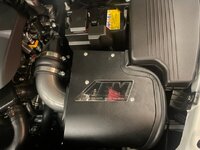An OEM air filter would typically see a pressure drop of around 0.5 to 2% of atmospheric pressure, resulting in a power loss of 0.5 to 2% relative to an engine running no air filter. If a K&N filter is half as restrictive as OEM, you might see an increase in power of 0.25-1% (though actually less, since ignition timing is more retarded at higher airflows). In terms of filtering efficiency, a K&N will allow over 10 times the amount of dust into the engine compared to a good paper filter, resulting in over 10 times the rate of engine wear.
Here is an ISO test of the efficiency of various air filters, included K&N. For an engine operated in a low-dust environment, this increased wear probably not result in the engine wearing out within the life of the vehicle, but for some engines it will. Outside of competitive racing, it doesn't seem wise to use an inefficient filter.
In terms of fuel economy, for modern fuel injected gasoline engines there is no difference in engine efficiency between a unrestrictive filter and one that is clogged, since fuel is metered based on measured airflow. Pumping losses are identical as well since the combined restriction of the filter and throttle will be unchanged (except at WOT). On carbureted engines, a restrictive filter will result in the engine running richer, usually resulting in reduced fuel economy. There is a good study on this (SAE 2012-01-1717).
On a diesel engine, a less restrictive filter may improve economy slightly in theory, since the engine is not throttled, and pumping losses will be reduced with less airbox restriction. However, a study on this (SAE 2013-01-0311) showed no measurable reduction in fuel efficiency, even with a very clogged filter.


